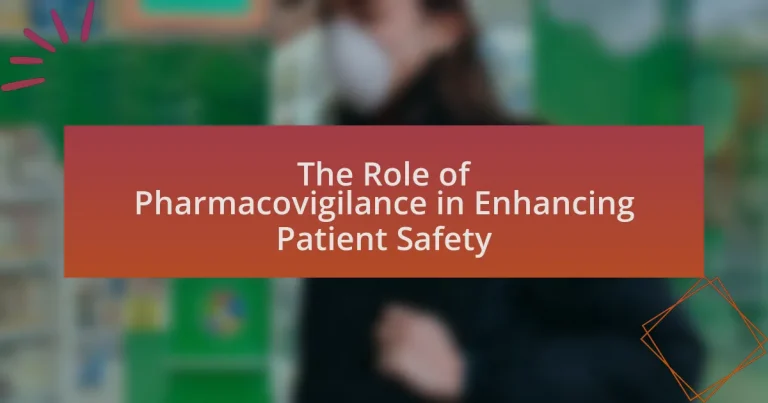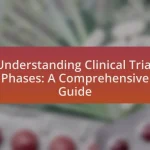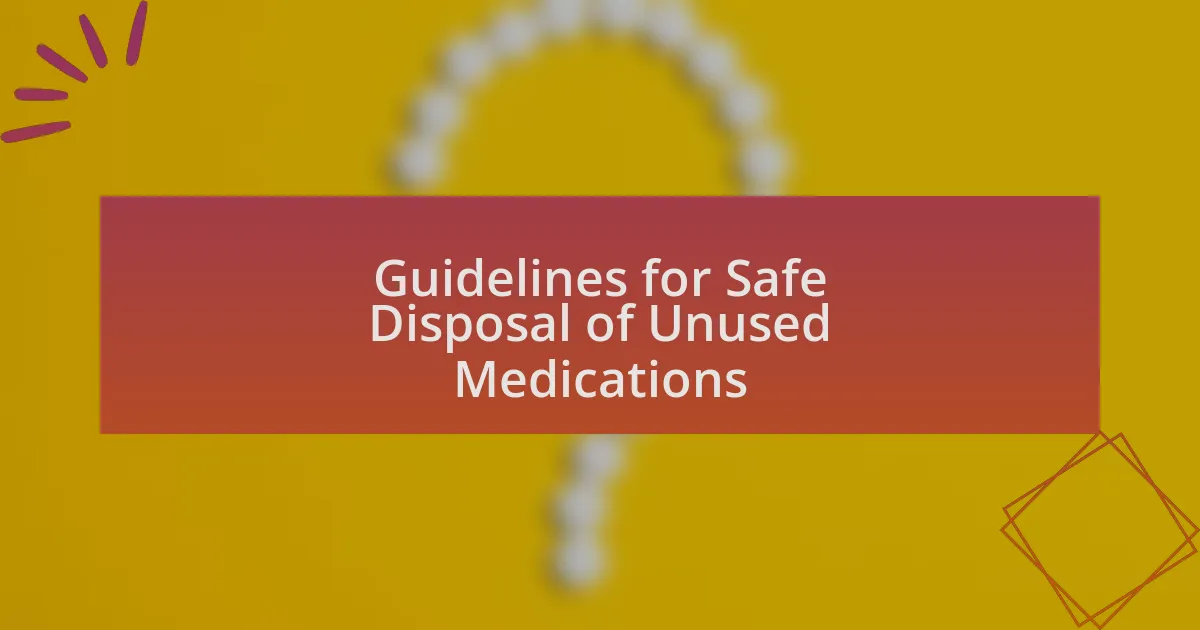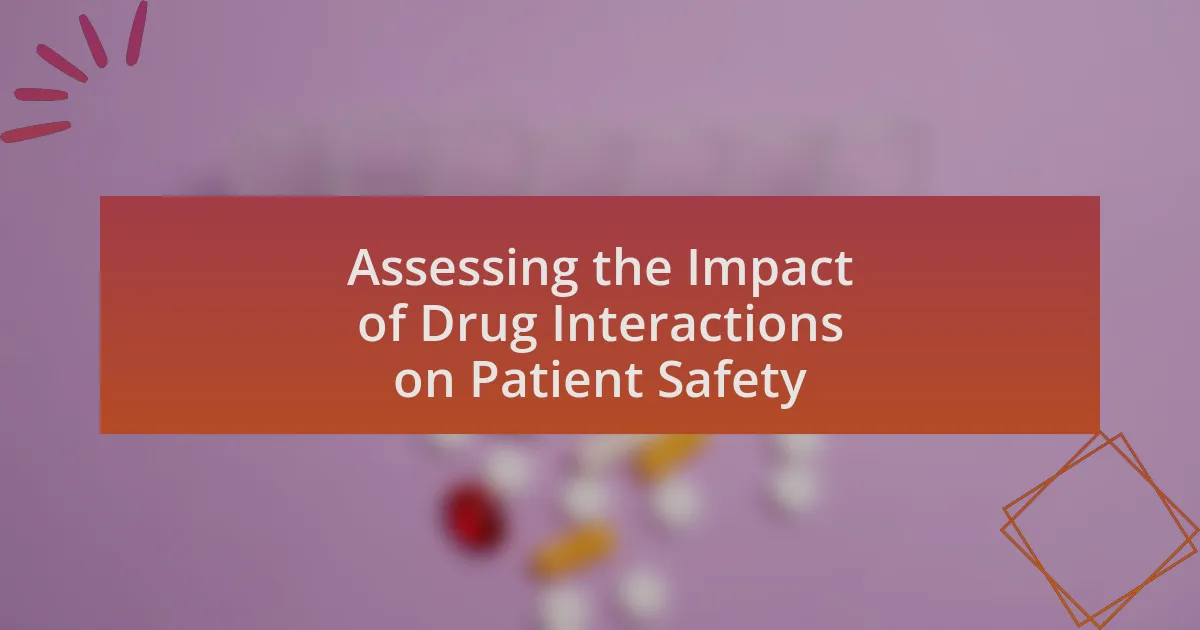Pharmacovigilance is a vital process in the healthcare system that focuses on enhancing patient safety by monitoring, assessing, and preventing adverse effects of medications. The article outlines the key processes involved in pharmacovigilance, including data collection, signal detection, and risk management strategies, which collectively contribute to identifying potential safety issues and minimizing medication-related harm. It also discusses the importance of regulatory compliance, the role of technology in improving data analysis, and the necessity of healthcare professional training to ensure effective pharmacovigilance practices. Furthermore, the article highlights the consequences of inadequate pharmacovigilance and explores future trends, emphasizing the significance of patient engagement in the evolution of drug safety monitoring.
What is the Role of Pharmacovigilance in Enhancing Patient Safety?
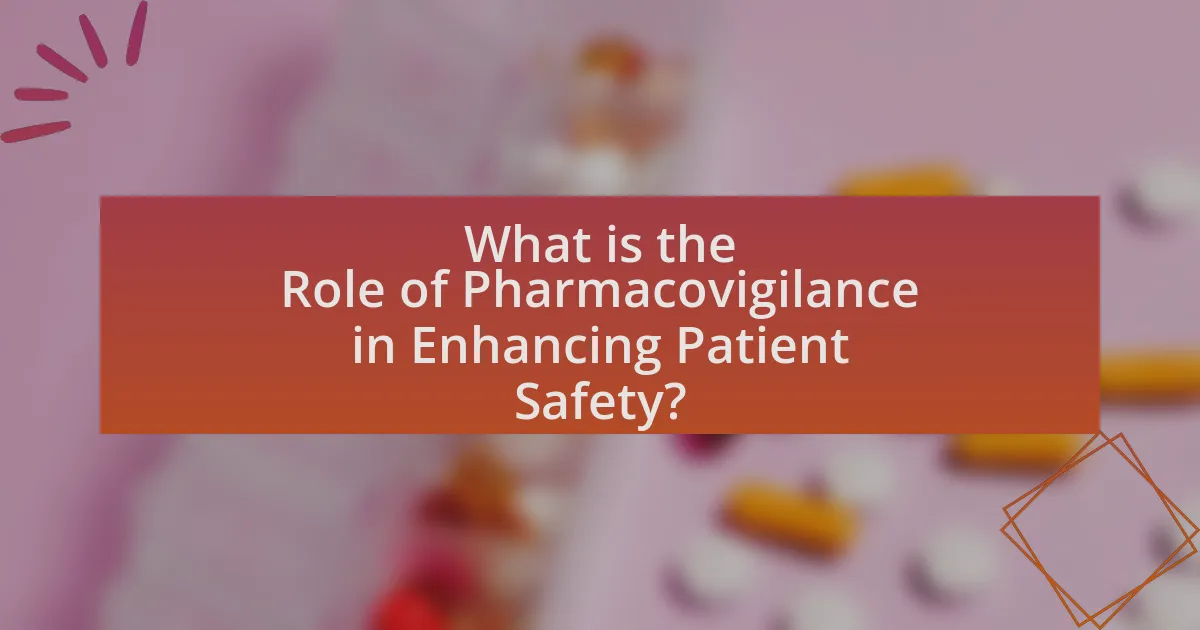
Pharmacovigilance plays a critical role in enhancing patient safety by monitoring, assessing, and preventing adverse effects of medications. This systematic approach involves the collection and analysis of data related to drug safety, which helps identify potential risks associated with pharmaceutical products. For instance, the World Health Organization reports that effective pharmacovigilance can lead to the identification of previously unrecognized adverse drug reactions, thereby informing healthcare providers and patients about safer medication practices. By ensuring that drug safety information is communicated effectively, pharmacovigilance contributes significantly to minimizing harm and improving overall patient outcomes.
How does Pharmacovigilance contribute to patient safety?
Pharmacovigilance contributes to patient safety by systematically monitoring, assessing, and understanding the adverse effects of medications. This process enables healthcare professionals and regulatory authorities to identify potential safety issues, leading to timely interventions such as label changes, warnings, or even drug withdrawals. For instance, the World Health Organization reported that effective pharmacovigilance systems can reduce medication-related harm by up to 50%, demonstrating its critical role in safeguarding patients.
What are the key processes involved in Pharmacovigilance?
The key processes involved in Pharmacovigilance include the collection, assessment, monitoring, and prevention of adverse drug reactions (ADRs). These processes ensure that any potential risks associated with pharmaceutical products are identified and managed effectively. For instance, the collection of data on ADRs is typically done through spontaneous reporting systems, clinical trials, and electronic health records, which provide a comprehensive view of drug safety. The assessment involves analyzing the collected data to determine the causal relationship between the drug and the adverse event, often utilizing statistical methods and expert evaluations. Monitoring is an ongoing process that tracks the safety profile of drugs post-marketing, ensuring that any new safety information is communicated to healthcare professionals and the public. Finally, prevention strategies may include risk minimization plans, labeling changes, and educational initiatives aimed at healthcare providers and patients. These processes collectively contribute to enhancing patient safety by ensuring that the benefits of medications outweigh their risks.
How does data collection impact patient safety in Pharmacovigilance?
Data collection significantly enhances patient safety in pharmacovigilance by enabling the identification and assessment of adverse drug reactions (ADRs). Accurate and comprehensive data allows healthcare professionals and regulatory authorities to monitor the safety profile of medications, leading to timely interventions and risk mitigation strategies. For instance, the World Health Organization emphasizes that robust data collection systems can detect safety signals early, which is crucial for preventing harm to patients. Furthermore, studies have shown that effective data collection can reduce the incidence of ADRs by up to 30%, demonstrating its critical role in safeguarding patient health.
Why is Pharmacovigilance essential in the healthcare system?
Pharmacovigilance is essential in the healthcare system because it systematically monitors, assesses, and improves the safety of medications. This process helps identify adverse drug reactions and medication errors, thereby minimizing risks to patients. For instance, the World Health Organization reports that pharmacovigilance activities have led to the detection of previously unknown side effects, which can significantly alter the risk-benefit profile of medications. By ensuring ongoing safety evaluations, pharmacovigilance contributes to informed clinical decision-making and enhances overall patient safety.
What are the consequences of inadequate Pharmacovigilance?
Inadequate pharmacovigilance can lead to severe consequences, including increased adverse drug reactions, compromised patient safety, and potential public health crises. When pharmacovigilance systems fail to monitor and report drug safety effectively, patients may experience unrecognized side effects, leading to hospitalizations or even fatalities. For instance, the thalidomide tragedy in the 1960s, where inadequate monitoring resulted in thousands of birth defects, underscores the critical need for robust pharmacovigilance. Furthermore, insufficient data on drug safety can hinder regulatory agencies’ ability to make informed decisions, ultimately affecting drug approval processes and public trust in medications.
How does Pharmacovigilance improve drug safety profiles?
Pharmacovigilance improves drug safety profiles by systematically monitoring, assessing, and understanding adverse drug reactions and other drug-related problems. This process involves collecting data from various sources, including clinical trials, post-marketing surveillance, and spontaneous reporting systems, which helps identify potential safety issues that may not have been evident during initial drug development. For instance, the World Health Organization reported that effective pharmacovigilance can lead to the identification of previously unknown side effects, thereby enabling timely regulatory actions, such as label changes or market withdrawals, which ultimately enhance patient safety.
What are the main challenges faced in Pharmacovigilance?
The main challenges faced in pharmacovigilance include data collection, signal detection, regulatory compliance, and resource limitations. Data collection is often hindered by underreporting of adverse drug reactions, which can lead to incomplete safety profiles. Signal detection is complicated by the vast amount of data generated, requiring sophisticated analytical methods to identify potential safety issues. Regulatory compliance poses challenges due to varying requirements across different jurisdictions, making it difficult for organizations to maintain consistent practices. Additionally, resource limitations, including staffing and funding, can restrict the effectiveness of pharmacovigilance activities, ultimately impacting patient safety.
How do regulatory requirements affect Pharmacovigilance practices?
Regulatory requirements significantly shape Pharmacovigilance practices by establishing mandatory protocols for monitoring drug safety and reporting adverse events. These regulations, such as those set forth by the FDA and EMA, dictate the frequency and format of safety data submissions, ensuring that pharmaceutical companies actively collect and analyze data on drug-related risks. For instance, the FDA’s REMS (Risk Evaluation and Mitigation Strategies) program requires specific risk management plans that directly influence how companies conduct their Pharmacovigilance activities. Compliance with these regulations not only enhances the reliability of safety data but also fosters public trust in medication safety, ultimately contributing to improved patient outcomes.
What role does technology play in overcoming Pharmacovigilance challenges?
Technology plays a crucial role in overcoming Pharmacovigilance challenges by enhancing data collection, analysis, and reporting processes. Advanced data analytics and machine learning algorithms enable the identification of adverse drug reactions more efficiently by processing large volumes of data from various sources, such as electronic health records and social media. For instance, the use of natural language processing allows for the extraction of relevant information from unstructured data, improving signal detection capabilities. Additionally, cloud-based platforms facilitate real-time reporting and collaboration among stakeholders, ensuring timely responses to safety concerns. These technological advancements contribute to more effective monitoring and management of drug safety, ultimately enhancing patient safety outcomes.
How does Pharmacovigilance interact with other healthcare practices?
Pharmacovigilance interacts with other healthcare practices by monitoring and assessing the safety of medications, which informs clinical decision-making and enhances patient safety. This interaction occurs through the collection of adverse event reports from healthcare professionals, which are analyzed to identify potential safety signals. For instance, data from pharmacovigilance systems can lead to updates in prescribing information, influencing how healthcare providers prescribe medications. Additionally, collaboration with regulatory agencies ensures that safety information is disseminated effectively, impacting public health policies and practices. The integration of pharmacovigilance data into electronic health records further supports healthcare providers in making informed treatment choices, thereby improving patient outcomes.
What specific methodologies are used in Pharmacovigilance?
Pharmacovigilance employs several specific methodologies to monitor and enhance patient safety. These methodologies include spontaneous reporting systems, cohort studies, case-control studies, and signal detection techniques. Spontaneous reporting systems allow healthcare professionals and patients to report adverse drug reactions, providing real-time data for analysis. Cohort studies track groups of patients over time to assess the incidence of adverse effects, while case-control studies compare patients with adverse effects to those without to identify potential risk factors. Signal detection techniques utilize statistical methods to identify patterns or signals in adverse event data, enabling timely interventions. These methodologies collectively contribute to the effective monitoring of drug safety and the prevention of harm to patients.
How do signal detection methods enhance patient safety?
Signal detection methods enhance patient safety by identifying potential safety issues related to medications and medical products before they lead to widespread harm. These methods analyze data from various sources, such as clinical trials, spontaneous reports, and electronic health records, to detect signals of adverse effects or interactions. For instance, the World Health Organization emphasizes that timely signal detection can prevent adverse drug reactions, which are responsible for significant morbidity and mortality. By proactively identifying these signals, healthcare providers can implement risk management strategies, adjust treatment protocols, and inform patients, ultimately reducing the incidence of preventable harm.
What role do risk management strategies play in Pharmacovigilance?
Risk management strategies are essential in pharmacovigilance as they systematically identify, assess, and mitigate risks associated with pharmaceutical products. These strategies enable regulatory authorities and pharmaceutical companies to monitor adverse drug reactions and ensure that the benefits of a drug outweigh its risks. For instance, the implementation of Risk Evaluation and Mitigation Strategies (REMS) in the United States has been crucial in managing the safety of certain medications, thereby enhancing patient safety and informing healthcare providers and patients about potential risks.
What are the best practices for effective Pharmacovigilance?
The best practices for effective Pharmacovigilance include establishing a robust reporting system, ensuring comprehensive data collection, and fostering collaboration among stakeholders. A robust reporting system allows healthcare professionals and patients to report adverse drug reactions efficiently, which is crucial for timely risk assessment. Comprehensive data collection involves gathering information from various sources, including clinical trials, post-marketing surveillance, and spontaneous reports, to create a complete safety profile of medications. Collaboration among stakeholders, such as regulatory authorities, pharmaceutical companies, and healthcare providers, enhances communication and facilitates the sharing of safety information, ultimately improving patient safety outcomes. These practices are supported by regulatory guidelines, such as those from the World Health Organization and the European Medicines Agency, which emphasize the importance of systematic monitoring and proactive risk management in Pharmacovigilance.
How can healthcare professionals improve their Pharmacovigilance reporting?
Healthcare professionals can improve their Pharmacovigilance reporting by enhancing their knowledge of adverse event reporting systems and actively participating in training programs. Increased awareness of the importance of reporting adverse drug reactions leads to more comprehensive data collection, which is crucial for patient safety. Studies indicate that healthcare professionals who receive targeted education on Pharmacovigilance are more likely to report adverse events accurately and promptly, thereby contributing to better drug safety monitoring.
What training is necessary for effective Pharmacovigilance implementation?
Effective Pharmacovigilance implementation requires comprehensive training in regulatory guidelines, adverse event reporting, risk management, and data analysis. Professionals must be well-versed in the principles of pharmacovigilance as outlined by organizations such as the World Health Organization and the International Council for Harmonisation, which emphasize the importance of monitoring drug safety and efficacy. Additionally, training should include practical experience in using pharmacovigilance databases and software, as well as understanding the ethical considerations involved in patient safety. This structured training ensures that personnel can accurately assess and report adverse drug reactions, ultimately enhancing patient safety.
What future trends can be expected in Pharmacovigilance?
Future trends in pharmacovigilance include the increased use of artificial intelligence and machine learning to enhance data analysis and signal detection. These technologies enable faster identification of adverse drug reactions by processing vast amounts of data from diverse sources, such as electronic health records and social media. Additionally, the integration of real-world evidence into pharmacovigilance practices is expected to grow, allowing for more comprehensive assessments of drug safety in diverse populations. Regulatory agencies are also likely to emphasize proactive risk management strategies, focusing on preemptive measures rather than reactive responses to safety issues. These trends are supported by ongoing advancements in technology and a growing emphasis on patient-centered approaches in healthcare.
How will advancements in technology shape the future of Pharmacovigilance?
Advancements in technology will significantly enhance the future of Pharmacovigilance by enabling real-time data collection and analysis. Technologies such as artificial intelligence and machine learning will facilitate the identification of adverse drug reactions more efficiently, allowing for quicker responses to safety concerns. For instance, AI algorithms can analyze vast amounts of patient data from electronic health records and social media to detect patterns indicative of drug-related issues. Additionally, the integration of blockchain technology can improve the traceability of drug safety data, ensuring transparency and reliability in reporting. These technological innovations will ultimately lead to improved patient safety outcomes by allowing for proactive risk management and more informed decision-making in drug regulation.
What role will patient engagement play in the evolution of Pharmacovigilance?
Patient engagement will play a crucial role in the evolution of Pharmacovigilance by enhancing data collection and improving safety monitoring. Engaged patients can provide real-time feedback on drug effects, leading to more accurate and timely reporting of adverse events. Studies indicate that patient-reported outcomes can significantly contribute to understanding drug safety profiles, as evidenced by the FDA’s initiative to incorporate patient perspectives into regulatory decisions. This shift towards a more collaborative approach in Pharmacovigilance not only empowers patients but also strengthens the overall safety framework, ultimately leading to better health outcomes.
What practical steps can be taken to enhance Pharmacovigilance in healthcare settings?
To enhance Pharmacovigilance in healthcare settings, implementing robust reporting systems for adverse drug reactions is essential. These systems should facilitate easy and anonymous reporting by healthcare professionals and patients, ensuring comprehensive data collection. Training healthcare providers on the importance of Pharmacovigilance and how to report adverse events effectively can significantly improve participation rates. Additionally, integrating electronic health records with Pharmacovigilance databases allows for real-time monitoring and analysis of drug safety data. Regular audits and feedback mechanisms can further strengthen the process by identifying gaps and areas for improvement. Evidence shows that countries with established reporting systems, such as the United States and European nations, have seen increased reporting rates and improved patient safety outcomes.
